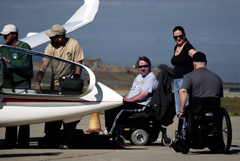
Spinal cord injury survivors glide over San Benito County
Curt Carrell is no stranger to the skies. In the ’90s, he flew
classical aerobatics and was good enough to compete.
Spinal cord injury survivors glide over San Benito County
Curt Carrell is no stranger to the skies. In the ’90s, he flew classical aerobatics and was good enough to compete.
“My whole life I was interested in it,” he said. “I loved airplanes and the idea of flying. As an adult when I had discretionary funds, I took lessons.”
He started out flying casually and eventually entered aerobatic competitions for five years.
But eight years ago one flight changed his life.
“I was practicing one day and I flooded a maneuver,” he said. “I didn’t have the altitude to recover. I didn’t take proper precautions.”
Carrell crashed and suffered a spinal cord injury. He has some use of his legs, but mostly uses a wheelchair to get around since the crutches required to help him walk tire him out.
At the Hollister Municipal Airport Oct. 19, Carrell had a chance to take to the skies once more along with others with spinal cord injuries. Carrell is a member of the Spinal Cord Injury Peer Support Group, which serves Santa Clara and the Marysville/Sacramento area. The group, run out of Santa Clara Valley Medical, offers support groups and plans activities that can accommodate members.
Carrell has participated in other modified activities such as scuba diving and adaptive skiing.
“I ski more now as a disabled person than as an able-bodied person,” he said.
For Friday’s event, members signed up for a time between 11 a.m. and 3 p.m. to take to the sky in a glider, a small aircraft with a long wing span that uses thermodynamics to stay airborne rather than a motor. The Bay Area Gliders group, a group that flies gliders out of Hollister, helped load people such as Carrell into the various gliders.
Another participant was Jim Lauth, who suffered a stroke more than four years ago that left him partially paralyzed on his left side. His wife, Tracy, traveled with him from Santa Clara to the Hollister airport, along with his service dog Molly, who accompanies him everywhere.
It was Lauth’s first trip in a glider.
“It was pretty smooth,” he said, of his one-hour ride. “It was a little bit different landing. You are right there and you can see the runway right in front of you. It’s a little unnerving, but we came down smooth.”
While in the sky, the glider pilot who accompanied Lauth let him try his hand at the controls.
“The pilot gave me a little bit of instruction and I did a couple little turns up there,” he said.
Lauth and Tracy were engaged and two weeks from being married when Lauth had his stroke. They were married in the hospital by a justice of the peace three days later. Before his stroke, the two were very active.
“He was a semi-pro athlete,” Tracy said. “We biked everywhere. He had a blood condidtion that caused a blood clot.”
Since then, the pair have found activities they can participate in but it usually takes a lot more planning.
“It requires a lot of patience on people’s part to accommodate him and not make him feel bad,” Tracy said. “A lot of times he doesn’t do things because he doesn’t want to put people out.”
The Bay Area glider members had worked with the peer group for a day of soaring a few years ago so have experience helping people like Lauth into the low-to-the ground airplanes.
“We need people that understand what’s going on and that’s one thing that was really good about this group,” Lauth said. “When we first got out, they tried me in the first glider and it really wasn’t the fit for me because of the way the seat was laid out and where my legs had to be.”
A few members and Tracy lifted Lauth out of one glider and back into to his wheelchair, and took him to another glider that would allow access to the controls. With his left-side paralysis, the members and his wife assisted him into the glider.
“When they tried me in another plane, that worked out perfect,” Lauth said.
While Lauth enjoyed the ride, his dog Molly was anxious while he was in the air, whining and keeping her tail down. Lauth and his wife raised Molly since she was a puppy and had her trained after his stroke. The dog accompanies Lauth to work, when he travels for business and even sleeps by his side at night. The first time they had been separated for months was during Lauth’s glider ride.
“The biggest thing she does for me, my wife says, is that when I come into the room instead of seeing a guy in a wheelchair, [people] see a cute dog,” Lauth joked.
For more information on spinal cord injury support groups, visit www.tbi-sci.org/sciresource.html.







